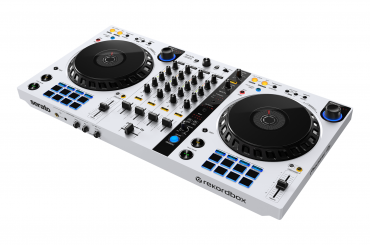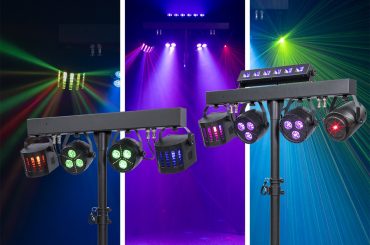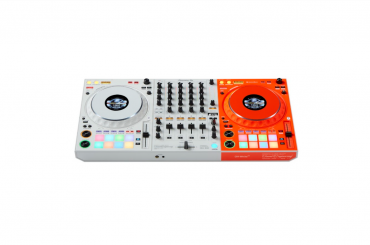Last month, I took a peek at Denon DJ’s incredible new SC5000 Prime media player. (Refer to the September 2017 print issue, or you can also read the review in the archives on our web site at djtimes.com.) The opinion I came away with was that the SC5000 is a superbly impressive, incredibly flexible, and intensely fun media player for the DJ market, with an industry-leading feature set and some really top-drawer engineering work in the embedded software that makes the player truly tick.
The SC5000 is not the only member of the Prime family at Denon DJ, however, and this month, I take a deep dive on the new X1800 Prime mixer. I could argue that the level of engineering work needed to make a successful DJ mixer is perhaps not as great as what went into the SC5000, or Denon DJ’s also-impressive MCX8000 DJ controller. But that’s not to say that there’s no room for innovation here, and Cumberland, R.I.-based inMusic Brands — parent of Denon DJ — has certainly proven that point with this new offering.
As I mentioned last month, Denon DJ introduced the Prime series back in January at the Winter NAMM Show 2017. The Prime family includes the SC5000, the X1800 Prime mixer, and the VL12 Prime turntable. It’s collectively serious gear for serious DJs, which was obvious in the demos back at NAMM, and it’s even more clear now that I’ve had a chance to really dig into the X1800 mixer.
Let’s start with the very basic of basics; the X1800 is a straightforward, four-channel DJ club mixer, with a suite of on-board effects that it could be argued are fairly industry-standard. Where the X1800 diverges from its competition is the level of integration it provides with the companion members of the Prime family, notably the SC5000 media player. Both aesthetically, and operationally, they are truly made for each other, and while it’s certainly possible to get a lot of utility out of both the SC5000s alone, and an X1800 alone, the total is greater than the sum of the parts, as they say, when you bring them together. Let’s take a deeper look at why.
Set-Up & Use: By and large, set-up and use of the X1800 Prime mixer is not entirely unlike any other DJ mixer. It’s mostly a matter of connecting power, and connecting all your inputs and outputs; not really a whole lot to that. The X1800 does offer a plethora of options, however; you get separate RCA line and phono stereo inputs across all four channels, as well as S/PDIF digital RCA input across all four channels and for master output. Booth outs are provided by TRS ¼-inch jacks, while balanced master outs are XLR (and unbalanced as RCA). There’s even a pair of record outs in RCA, plus TRS ¼-inch send and receive for offboard effects units. One of the two mic inputs is on the back panel too (¼-inch; the second mic, with a Neutrik-style combo connector, is on the top surface of the unit). You’ll also find a standard 5-pin DIN connector for MIDI out (yes, it provides that capability, too).
Five RJ-45 jacks are offered for control connectivity. Using standard Ethernet cables, you connect up to four SC5000 units to the X1800, which allows the SC5000 media players to seamlessly share content between any players. Additionally, the X1800 auto-configures based on the SC5000 units connected, providing both easy mapping of channels, as well as visual indications of which layer on which deck is assigned to which fader — along with what’s currently “on air.” It’s a really slick capability that makes using the Prime series hardware simple, intuitive, and trouble-free.
One of the nice capabilities here is that you can assign colors to layers within the SC5000s, and those colors are then reflected in the backlight color of the cue buttons on the X1800, providing consistent, color-based feedback of which layer is which across all the connected hardware. I chose to set the layers on the left SC5000 in blue and green, and those of the right deck in yellow and red. There was never any confusion about what’s what, which track is playing, which fader goes with which layer, etc. Small feature, but slick, and very useful.
(NOTE: “Layers” refers to the capability of a single SC5000 to behave as two decks, and provide playback of two programs simultaneously. Refer to my review last month for more information on that. Using SC5000s with an X1800 makes it much more intuitive to manipulate those layers during a performance, for the reasons I just mentioned.)
On the top of the unit, there are a pair of USB ports that allow the X1800 to be connected to a computer, during which it functions as a USB Audio Class device — which is to say that it appears to the computer as any other type of audio input/output device. What gets routed to the computer, and how, can be configured with the X1800’s onboard Utility functions.
Those Utility functions provide a gateway to a whole range of configuration options, including channel EQ behavior, filter resonance, headphone attenuation, various microphone options, the handling of various audio settings (including the aforementioned USB), along with some general system options. Perhaps my only complaint here is that the LCD display on the top surface of the unit is a bit smaller than I would have ideally liked, but that’s a small nit; the fine-grained configuration control was certainly welcomed.
Once everything was hooked up, which was a pretty simple affair with the pair of SC5000 media players I was provided for review (I chose to use the single RCA digital S/PDIF for audio, and the Ethernet link cabling), I was off to the races.
Not surprisingly, Denon DJ stuck close to the script for the layout of controls on the X1800. I’d argue that it’s not a place to try and be innovative if you want professional DJs to embrace your hardware; having all the knobs and faders in roughly their expected positions makes it easy to walk up to an X1800 for the first time and be immediately productive.
That was certainly my experience; without cracking the manuals of either the SC5000s or the X1800, after the connections were made, I was performing a capable DJ set pretty much out of the gate. About the only things that need tweaking are the per-channel gain levels, as well as (obviously) the signal source on a channel-by-channel basis (choosing from among digital, line, phono, USB and DVS). Obviously, the setting controls the behavior of the channel, and as you can tell from the list of options, speaks to the X1800’s flexibility to integrate into a range of DJ workflow types. These include conventional turntables or media players, whether playing back actual audio or control media, as well as computer-based DJ software — or, of course, hybrid combinations of those.
In addition to the standard tri-band EQ, the X1800 provides a single-knob HPF/LPF filter, as well as a sweep FX knob, on a per-channel basis (with a global on/off button for the filter). With regard to the filter, I’ve always preferred separate low- and high-pass filters to single-knob solutions, but like the use of a crossfader, that’s a personal preference and style issue, and your mileage may vary, as they say. The sweep FX knobs allow you to dial in one of four sweep effects (dub echo, noise, wash out, and gate) on a channel-by-channel basis.
Farther down the top panel are the channel faders, along with switches to control crossfader behavior, including the ability to disable it entirely (my personal preference).
To the left on the top panel you’ll find mic and headphone controls. First, I always appreciate a DJ mixer with two mic inputs; it’s a virtual necessity for any mobile DJ. I also appreciate the ability to control EQ and level from the top panel. The aforementioned Utility menu gives you even more setting options to control mic behavior and performance.
The right side of the unit has two vertical sections, one controlling output levels, primarily, and a larger section with the USB connectors mentioned earlier, as well as the onboard BPM effects unit (and Utility functions).
The effects unit has all the usual options, including echo, delay, ping-pong, flanger, phaser, reverb, and more. Selection and configuration are shown on the LCD display. All the effects are beat-synced, with selectable duration from 1/16 of a beat to 8 beats. The BPM information can be manually set, or is auto-set from data sent from SC5000 media players when used with the X1800.
Conclusions: The bottom line is that the X1800 provides a full range of capabilities, all the expected features, and a few extras that make it a dream to use. With its solid design and construction, as well as its top-notch accuracy, it makes a terrific mixer choice for serious DJs in demanding club environments. But the pre-integration with the SC5000 Prime media players make it the obvious choice for pairing with them, providing plug-and-play ease with powerful extra features that make everything even easier (and more fun) to use. Like the SC5000 media players, the X1800 Prime mixer has a street price in the general neighborhood of $1,900, making it an investment. But as I said in last month’s wrap-up about the SC5000, what you get for that investment reflects the high bar for quality and performance that Denon DJ is setting for products in this space. Along with the SC5000 Prime media players, the X1800 Prime mixer is a lustworthy piece of kit indeed.








